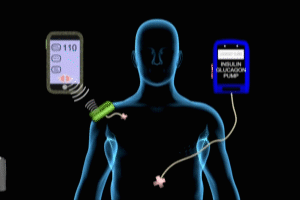Related Article
Related Article
Bionic Pancreas MET010
Related Article
Bionic Pancreas Transcript
The Bionic Pancreas
This is Dr. Cal Shipley with a review of the bionic pancreas.
Bionic Pancreas Components
In order for the bionic pancreas to incorporate the essential functions of the human pancreas, the following components are required as seen in this image: A smartphone acts as the command and control center, housing the software program that determines what actions to take based on data being fed to it from the glucometer, a glucometer capable of continuous monitoring of blood glucose levels.
Continuous Glucose Monitoring
In his recent study comparing the effectiveness of a bionic pancreas compared to an insulin pump, Stephen J. Russell, M.D., a leading researcher in the field, utilized a Dexcom G4 PLATINUM continuous monitor glucometer.
The beauty of continuous operation glucometers such as the G4 is that they are accurately able to assess blood glucose levels via a subcutaneously placed probe and do not require a direct interface with the bloodstream in order to obtain accurate data. Moreover, the glucometer has the capability of communicating its data wirelessly to the a cell phone in the system.
Insulin Pump
The third component of the bionic pancreatic system is a pump which contains separate reservoirs of both insulin and glucagon, and can then inject either hormone subcutaneously into the user on a signal from the cell phone program.
Typically, in a bionic pancreatic system, the glucometer is set to transmit data regarding blood glucose levels to the cell phone program at a short interval, repeatedly, on an ongoing basis. For example, every five minutes, 24/7.
If the blood glucose level reported is within a specified normal range, no action is taken by the software program. If the reported blood glucose level is above the normal range, then the smartphone-based software program wirelessly messages the insulin glucagon module and instructs it to inject insulin. If the reported blood glucose level is below the normal range, then the software program instructs the insulin glucagon module to inject a dose of glucagon.
Bionic Pancreas versus Insulin Pump Alone
There are two major advantages of a bionic pancreatic system over standard insulin pump therapy for diabetes. The software program of the bionic pancreas system makes treatment decisions based on real-time glucose level data and makes new treatment decisions every few minutes around the clock. The insulin pump lacks any type of automated system for assessing blood glucose levels and continuous or burst injections of insulin are strictly determined by manual external input. This means that the insulin pump cannot correct situations of hypoglycemia as may occur in diabetic patients who are attempting a tight control of their disease.
If you haven’t already had a chance to read through it, please take a look at my blog on the bionic pancreas to get more information. For more information on insulin pumps and how they work, please see my animation in the endocrine metabolic library.
Cal Shipley M.D., copyright 2020

